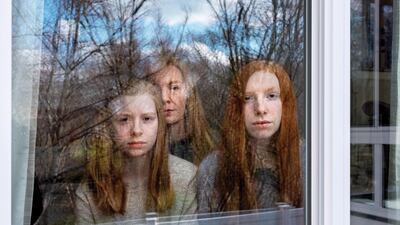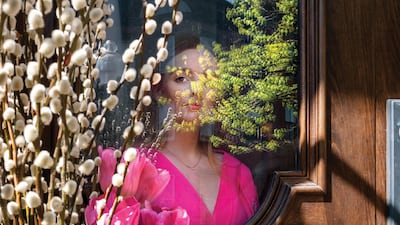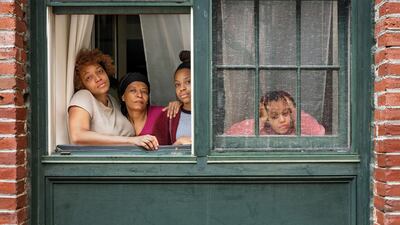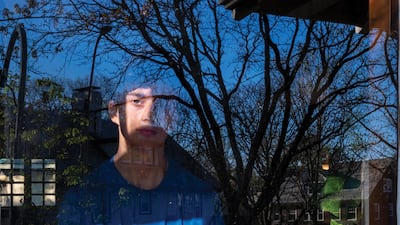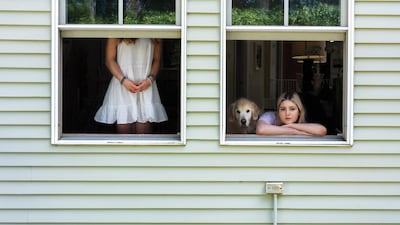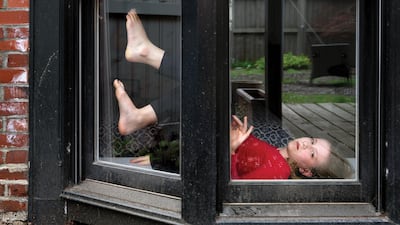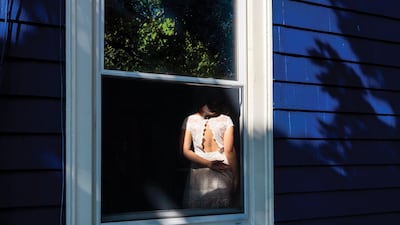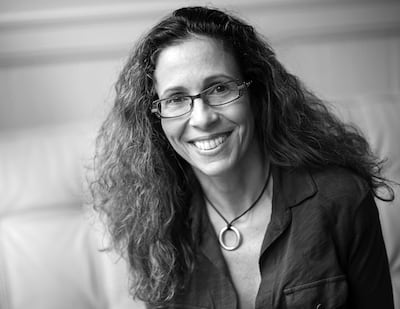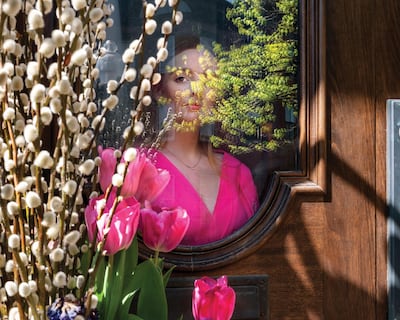It’s easy to forget, more than a year after the first wave of the coronavirus swept the world, just how isolating and strange the early weeks of lockdown were. Billions of people were suddenly confined to their homes, isolated from relatives, friends and colleagues. Long-awaited events – holidays, graduations, weddings – were cancelled. Worlds narrowed to the walls of homes that had suddenly become offices and schools, sanctuaries and prisons.
Last spring, when the first Covid-related lockdown began in Massachusetts, Lebanese- American photographer Rania Matar felt an urge to document the strange and isolating period. Within the first weeks, she asked in a post on her Instagram page if anyone within a 48-kilometre radius of her home in the town of Brookline would be willing to be photographed through the windows of their homes.
“I got flooded with replies. I never expected that,” she recalls. “It proved to me how much people were craving that same connectivity that I was.”
Standing in people’s gardens, safely distanced and wrapped up against the cold, Matar photographed dozens of strangers trapped behind glass, cut off from the outside world. With no idea how long the restrictions would last, she worked feverishly to document the strange period of limbo, sometimes visiting two or three homes in one day.
Launched this week, Matar’s solo exhibition, On Either Side of the Window: Portraits during Covid-19, on show at Cornell Fine Arts Museum in Florida, provides a moving overview of a lost year, capturing people who weathered months of fear and uncertainty, and navigated stasis and change, isolation and connection, as the pandemic shrunk their worlds down to a few square metres.
Identified by name and location, some of her subjects look out at the world from which they have been cut off. Others keep their gazes fixed inside their homes, as though even their thoughts are locked away.
In Sally, Ella, Tori, a woman and two red-headed girls stare pensively out at their garden. A reflection of the view they are witnessing makes the bare branches of winter trees splay skywards above their heads like antlers.
Early on people were in their sweats and their pyjamas, but as time went by, people started dressing up for the shoots and there was an element of performance
Throughout the series, Matar plays with reflections in ingenious ways, incorporating them into her compositions. They play an evocative dual role in her portraits, revealing the world outside the window at the same time as they conceal the interior of the houses, creating a double-exposure-like effect. Her subjects, cut off from the natural world outside, are simultaneously subsumed by it.
The careful balance posed an interesting technical challenge. “What was interesting was the more light there was outside, the harder it was for me to see the person in the window, so it’s like the opposite of photography, where you need light to shoot,” says Matar, who found it challenging to ensure she was not visible in the reflections.
As the months passed, leaves began to unfurl on the trees and plants burst into bloom. The photographs in the exhibition reveal the passing of time through shifting reflections of the changing landscapes outside people’s windows.
In the spring-like Austin, a young woman in a pink dress is framed by the window set into her wooden front door. A bunch of bright tulips in the foreground match the colour of her dress and a spray of white blooms give the portrait a posed, festive feel. A scatter of bright yellow flowers reflected from the garden overlay her face, partially concealing her from view.
By contrast, Marie has an autumnal feel. A grey-haired woman is captured in profile, the red of her blouse echoing the fiery hue of the maple leaves outside her window.
Matar, who specialises in portraiture and has focused for many years on girls and women, decided that for this ongoing project she would photograph everybody who wanted to participate. To date, she has visited more than 150 houses, photographing women and men, children and old people, couples and whole families with their pets.
She took a ladder with her on shoots and would often circle the house looking for the best window to capture a striking photograph. “A lot of times I didn’t know the people and I never knew what to expect, so it was really going there, experiencing what was happening at the moment and making the best of it,” she says.
More than just an artistic undertaking, the project became a means of connecting with people.
“People were excited to actually have someone come to their door, so I would have little trinkets hanging there for me, and that was so touching,” says Matar. “Somebody did a little painting for me. Somebody left a chocolate. Somebody gave me a bouquet of flowers … There was something happening that was pretty important, for me and for the people on the other side.”
Intimate and haunting, Matar’s portraits convey a sense that despite being cut off from each other, her subjects are linked by a shared experience, immersed in a state of suspension, waiting for life to resume.
“There’s always this rhetoric that defines a lot of my work because I come from two cultures that are seemingly at war with each other,” she says. “I live in the US and all you hear about the Middle East is horrors. So in all my work, I’m trying to focus on that shared humanity.
“At that time my father, my parents, my friends were all in lockdown in Lebanon and I’m on lockdown here, so there was this shared experience that was very universal. There was none of that ‘them-versus-us’ anymore. The world shut down.”
But as people began to adjust to life in lockdown, the way Matar’s subjects approached the photo shoots changed. “Early on people were in their sweats and their pyjamas, but as time went by, people started dressing up for the shoots and there was an element of performance,” she says. “In the beginning, it felt like there was a heaviness, like time being still, and I think as we all adjusted to that, it became the new normal.”
In one of the exhibition's most dramatic and evocative photos, Mia and Jun, the woman is dressed in a dramatic red evening gown and the man, behind her, wears a deep red shirt. They stand at their back door, hands splayed against the glass like prisoners desperate for escape.
Matar says while life appeared to be on pause, the people she photographed experienced birthdays and graduations, weddings and funerals over the course of the year.
Among the most moving images are a rare repeated portrait of the same person. Taken through an open window, Susan captures a pregnant woman in a long white dress, her face concealed by the curtain of hair she is brushing with a large green hairbrush. In the next photograph, taken through the same window, she stands breastfeeding her baby, her face bathed in sunlight, as her husband brushes her hair. The series is a poignant reminder than even in lockdown, life goes on.
A virtual tour of On Either Side of the Window is on view at my.matterport.com until May 9
Company Profile
Name: Thndr
Started: 2019
Co-founders: Ahmad Hammouda and Seif Amr
Sector: FinTech
Headquarters: Egypt
UAE base: Hub71, Abu Dhabi
Current number of staff: More than 150
Funds raised: $22 million
SPECS
Engine: 4-litre V8 twin-turbo
Power: 630hp
Torque: 850Nm
Transmission: 8-speed Tiptronic automatic
Price: From Dh599,000
On sale: Now
Zimbabwe v UAE, ODI series
All matches at the Harare Sports Club
- 1st ODI, Wednesday, April 10
- 2nd ODI, Friday, April 12
- 3rd ODI, Sunday, April 14
- 4th ODI, Sunday, April 16
Squads:
- UAE: Mohammed Naveed (captain), Rohan Mustafa, Ashfaq Ahmed, Shaiman Anwar, Mohammed Usman, CP Rizwan, Chirag Suri, Mohammed Boota, Ghulam Shabber, Sultan Ahmed, Imran Haider, Amir Hayat, Zahoor Khan, Qadeer Ahmed
- Zimbabwe: Peter Moor (captain), Solomon Mire, Brian Chari, Regis Chakabva, Sean Williams, Timycen Maruma, Sikandar Raza, Donald Tiripano, Kyle Jarvis, Tendai Chatara, Chris Mpofu, Craig Ervine, Brandon Mavuta, Ainsley Ndlovu, Tony Munyonga, Elton Chigumbura
TECH%20SPECS%3A%20APPLE%20IPHONE%2014%20PLUS
%3Cp%3E%3Cstrong%3EDisplay%3A%3C%2Fstrong%3E%206.1%22%20Super%20Retina%20XDR%20OLED%2C%202778%20x%201284%2C%20458ppi%2C%20HDR%2C%20True%20Tone%2C%20P3%2C%201200%20nits%3C%2Fp%3E%0A%3Cp%3E%3Cstrong%3EProcessor%3A%3C%2Fstrong%3E%20A15%20Bionic%2C%206-core%20CPU%2C%205-core%20GPU%2C%2016-core%20Neural%20Engine%C2%A0%3C%2Fp%3E%0A%3Cp%3E%3Cstrong%3EMemory%3A%3C%2Fstrong%3E%206GB%3C%2Fp%3E%0A%3Cp%3E%3Cstrong%3ECapacity%3A%3C%2Fstrong%3E%20128%2F256%2F512GB%3C%2Fp%3E%0A%3Cp%3E%3Cstrong%3EPlatform%3A%3C%2Fstrong%3E%20iOS%2016%3C%2Fp%3E%0A%3Cp%3E%3Cstrong%3EMain%20camera%3A%3C%2Fstrong%3E%20Dual%2012MP%20main%20(f%2F1.5)%20%2B%2012MP%20ultra-wide%20(f%2F2.4)%3B%202x%20optical%2C%205x%20digital%3B%20Photonic%20Engine%2C%20Deep%20Fusion%2C%20Smart%20HDR%204%2C%20Portrait%20Lighting%3C%2Fp%3E%0A%3Cp%3E%3Cstrong%3EMain%20camera%20video%3A%3C%2Fstrong%3E%204K%20%40%2024%2F25%2F3060fps%2C%20full-HD%20%40%2025%2F30%2F60fps%2C%20HD%20%40%2030fps%3B%20HD%20slo-mo%20%40%20120%2F240fps%3B%20night%2C%20time%20lapse%2C%20cinematic%2C%20action%20modes%3B%20Dolby%20Vision%2C%204K%20HDR%3C%2Fp%3E%0A%3Cp%3E%3Cstrong%3EFront%20camera%3A%3C%2Fstrong%3E%2012MP%20TrueDepth%20(f%2F1.9)%2C%20Photonic%20Engine%2C%20Deep%20Fusion%2C%20Smart%20HDR%204%3B%20Animoji%2C%20Memoji%3B%20Portrait%20Lighting%3C%2Fp%3E%0A%3Cp%3E%3Cstrong%3EFront%20camera%20video%3A%3C%2Fstrong%3E%204K%20%40%2024%2F25%2F3060fps%2C%20full-HD%20%40%2025%2F30%2F60fps%2C%20HD%20slo-mo%20%40%20120fps%3B%20night%2C%20time%20lapse%2C%20cinematic%2C%20action%20modes%3B%20Dolby%20Vision%2C%204K%20HDR%3C%2Fp%3E%0A%3Cp%3E%3Cstrong%3EBattery%3A%3C%2Fstrong%3E%204323%20mAh%2C%20up%20to%2026h%20video%2C%2020h%20streaming%20video%2C%20100h%20audio%3B%20fast%20charge%20to%2050%25%20in%2030m%3B%20MagSafe%2C%20Qi%20wireless%20charging%3C%2Fp%3E%0A%3Cp%3E%3Cstrong%3EConnectivity%3A%3C%2Fstrong%3E%20Wi-Fi%2C%20Bluetooth%205.3%2C%20NFC%20(Apple%20Pay)%3C%2Fp%3E%0A%3Cp%3E%3Cstrong%3EBiometrics%3A%3C%2Fstrong%3E%20Face%20ID%3C%2Fp%3E%0A%3Cp%3E%3Cstrong%3EI%2FO%3A%3C%2Fstrong%3E%20Lightning%3C%2Fp%3E%0A%3Cp%3E%3Cstrong%3ECards%3A%3C%2Fstrong%3E%20Dual%20eSIM%20%2F%20eSIM%20%2B%20SIM%20(US%20models%20use%20eSIMs%20only)%3C%2Fp%3E%0A%3Cp%3E%3Cstrong%3EColours%3A%3C%2Fstrong%3E%20Blue%2C%20midnight%2C%20purple%2C%20starlight%2C%20Product%20Red%3C%2Fp%3E%0A%3Cp%3E%3Cstrong%3EIn%20the%20box%3A%3C%2Fstrong%3E%20iPhone%2014%2C%20USB-C-to-Lightning%20cable%2C%20one%20Apple%20sticker%3C%2Fp%3E%0A%3Cp%3E%3Cstrong%3EPrice%3A%3C%2Fstrong%3E%20Dh3%2C799%20%2F%20Dh4%2C199%20%2F%20Dh5%2C049%3C%2Fp%3E%0A
BLACK%20ADAM
%3Cp%3E%3Cstrong%3EDirector%3A%3C%2Fstrong%3E%20Jaume%20Collet-Serra%3C%2Fp%3E%0A%3Cp%3E%3Cstrong%3EStars%3A%3C%2Fstrong%3E%20Dwayne%20Johnson%2C%20Sarah%20Shahi%2C%20Viola%20Davis%2C%20Pierce%20Brosnan%3C%2Fp%3E%0A%3Cp%3E%3Cstrong%3ERating%3A%20%3C%2Fstrong%3E3%2F5%3C%2Fp%3E%0A
'Young girls thinking of big ideas'
Words come easy for aspiring writer Afra Al Muhairb. The business side of books, on the other hand, is entirely foreign to the 16-year-old Emirati. So, she followed her father’s advice and enroled in the Abu Dhabi Education Council’s summer entrepreneurship course at Abu Dhabi University hoping to pick up a few new skills.
“Most of us have this dream of opening a business,” said Afra, referring to her peers are “young girls thinking of big ideas.”
In the three-week class, pupils are challenged to come up with a business and develop an operational and marketing plan to support their idea. But, the learning goes far beyond sales and branding, said teacher Sonia Elhaj.
“It’s not only about starting up a business, it’s all the meta skills that goes with it -- building self confidence, communication,” said Ms Elhaj. “It’s a way to coach them and to harness ideas and to allow them to be creative. They are really hungry to do this and be heard. They are so happy to be actually doing something, to be engaged in creating something new, not only sitting and listening and getting new information and new knowledge. Now they are applying that knowledge.”
Afra’s team decided to focus their business idea on a restaurant modelled after the Leaning Tower of Pisa. Each level would have a different international cuisine and all the meat would be halal. The pupils thought of this after discussing a common problem they face when travelling abroad.
“Sometimes we find the struggle of finding halal food, so we just eat fish and cheese, so it’s hard for us to spend 20 days with fish and cheese,” said Afra. “So we made this tower so every person who comes – from Africa, from America – they will find the right food to eat.”
rpennington@thenational.ae
Company profile
Name: Tharb
Started: December 2016
Founder: Eisa Alsubousi
Based: Abu Dhabi
Sector: Luxury leather goods
Initial investment: Dh150,000 from personal savings
BEACH SOCCER WORLD CUP
Group A
Paraguay
Japan
Switzerland
USA
Group B
Uruguay
Mexico
Italy
Tahiti
Group C
Belarus
UAE
Senegal
Russia
Group D
Brazil
Oman
Portugal
Nigeria
Company: Instabug
Founded: 2013
Based: Egypt, Cairo
Sector: IT
Employees: 100
Stage: Series A
Investors: Flat6Labs, Accel, Y Combinator and angel investors
What is blockchain?
Blockchain is a form of distributed ledger technology, a digital system in which data is recorded across multiple places at the same time. Unlike traditional databases, DLTs have no central administrator or centralised data storage. They are transparent because the data is visible and, because they are automatically replicated and impossible to be tampered with, they are secure.
The main difference between blockchain and other forms of DLT is the way data is stored as ‘blocks’ – new transactions are added to the existing ‘chain’ of past transactions, hence the name ‘blockchain’. It is impossible to delete or modify information on the chain due to the replication of blocks across various locations.
Blockchain is mostly associated with cryptocurrency Bitcoin. Due to the inability to tamper with transactions, advocates say this makes the currency more secure and safer than traditional systems. It is maintained by a network of people referred to as ‘miners’, who receive rewards for solving complex mathematical equations that enable transactions to go through.
However, one of the major problems that has come to light has been the presence of illicit material buried in the Bitcoin blockchain, linking it to the dark web.
Other blockchain platforms can offer things like smart contracts, which are automatically implemented when specific conditions from all interested parties are reached, cutting the time involved and the risk of mistakes. Another use could be storing medical records, as patients can be confident their information cannot be changed. The technology can also be used in supply chains, voting and has the potential to used for storing property records.
Try out the test yourself
Q1 Suppose you had $100 in a savings account and the interest rate was 2 per cent per year. After five years, how much do you think you would have in the account if you left the money to grow?
a) More than $102
b) Exactly $102
c) Less than $102
d) Do not know
e) Refuse to answer
Q2 Imagine that the interest rate on your savings account was 1 per cent per year and inflation was 2 per cent per year. After one year, how much would you be able to buy with the money in this account?
a) More than today
b) Exactly the same as today
c) Less than today
d) Do not know
e) Refuse to answer
Q4 Do you think that the following statement is true or false? “Buying a single company stock usually provides a safer return than a stock mutual fund.”
a) True
b) False
d) Do not know
e) Refuse to answer
The “Big Three” financial literacy questions were created by Professors Annamaria Lusardi of the George Washington School of Business and Olivia Mitchell, of the Wharton School of the University of Pennsylvania.
Answers: Q1 More than $102 (compound interest). Q2 Less than today (inflation). Q3 False (diversification).
Heather, the Totality
Matthew Weiner,
Canongate
The specs
Engine: 4.0-litre, twin-turbocharged V8
Transmission: nine-speed automatic
Power: 630bhp
Torque: 900Nm
Price: Dh810,000
TRAP
Starring: Josh Hartnett, Saleka Shyamalan, Ariel Donaghue
Director: M Night Shyamalan
Rating: 3/5
Asia Cup Qualifier
Venue: Kuala Lumpur
Result: Winners play at Asia Cup in Dubai and Abu Dhabi in September
Fixtures:
Wed Aug 29: Malaysia v Hong Kong, Nepal v Oman, UAE v Singapore
Thu Aug 30: UAE v Nepal, Hong Kong v Singapore, Malaysia v Oman
Sat Sep 1: UAE v Hong Kong, Oman v Singapore, Malaysia v Nepal
Sun Sep 2: Hong Kong v Oman, Malaysia v UAE, Nepal v Singapore
Tue Sep 4: Malaysia v Singapore, UAE v Oman, Nepal v Hong Kong
Thu Sep 6: Final
Asia Cup
Venue: Dubai and Abu Dhabi
Schedule: Sep 15-28
Teams: Afghanistan, Bangladesh, India, Pakistan, Sri Lanka, plus the winner of the Qualifier
Real estate tokenisation project
Dubai launched the pilot phase of its real estate tokenisation project last month.
The initiative focuses on converting real estate assets into digital tokens recorded on blockchain technology and helps in streamlining the process of buying, selling and investing, the Dubai Land Department said.
Dubai’s real estate tokenisation market is projected to reach Dh60 billion ($16.33 billion) by 2033, representing 7 per cent of the emirate’s total property transactions, according to the DLD.
'I Want You Back'
Director:Jason Orley
Stars:Jenny Slate, Charlie Day
Rating:4/5
More coverage from the Future Forum
UK's plans to cut net migration
Under the UK government’s proposals, migrants will have to spend 10 years in the UK before being able to apply for citizenship.
Skilled worker visas will require a university degree, and there will be tighter restrictions on recruitment for jobs with skills shortages.
But what are described as "high-contributing" individuals such as doctors and nurses could be fast-tracked through the system.
Language requirements will be increased for all immigration routes to ensure a higher level of English.
Rules will also be laid out for adult dependants, meaning they will have to demonstrate a basic understanding of the language.
The plans also call for stricter tests for colleges and universities offering places to foreign students and a reduction in the time graduates can remain in the UK after their studies from two years to 18 months.
